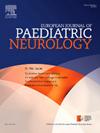Pediatric paroxysmal movement disorders - A clinical epidemiological study in an Irish cohort
IF 2.3
3区 医学
Q3 CLINICAL NEUROLOGY
引用次数: 0
Abstract
Background
Paroxysmal movement disorders (PxMD) are characterized by episodic involuntary movements and include paroxysmal dyskinesias (PD) and episodic ataxias (EA). Although reported in the medical literature since 1892, the exact prevalence in children is unknown.
Objectives
To determine the prevalence and clinical characteristics of PxMD in the pediatric population in the Republic of Ireland.
Methods
Cross-sectional cohort study across pediatric neurology services in the Republic of Ireland incorporating retrospective chart, telephone and clinical reviews.
Results
Seventy-nine cases met the inclusion criteria (PD = 37, EA = 38, Alternating Hemiplegia of Childhood = 4). Point prevalence for all PxMD was 6.5 cases per 100,000 persons aged less than 18 years (PD 3/100,000, EA 3.1/100,000, Alternating Hemiplegia of Childhood 0.3/100,000). Sixty-four cases were clinically reviewed by the research team (PD = 33, EA = 31). A cause was identified in 38 % (24/64). The highest investigation yield was from single-gene testing (38 %, 9/24) followed by gene panels (25 %, 11/44). Variable evolution patterns were seen. In PD, 55 % (18/33) resolved and 30 % (10/33) improved. This was due to medication in 61 % (20/33), trigger avoidance in 6 % (2/33) and spontaneous remission in 18 % (6/33). In EA, 45 % (14/31) resolved and 42 % (13/31) improved, with spontaneous remission or improvement in 48 % (17/33).
Discussion
This study adds to the PxMD knowledge base by determining PxMD prevalence in a pediatric population for the first time. This prevalence is higher than previous adult population estimates. An aetiology was identified in one-third. A large proportion can expect symptom improvement either with medications, trigger avoidance or spontaneous remission over time.
儿童阵发性运动障碍-爱尔兰队列的临床流行病学研究
背景:阵发性运动障碍(PxMD)以发作性不自主运动为特征,包括阵发性运动障碍(PD)和阵发性共济失调(EA)。尽管自1892年以来医学文献中就有报道,但儿童的确切患病率尚不清楚。目的了解爱尔兰儿童人群中PxMD的患病率和临床特征。方法对爱尔兰共和国儿童神经病学服务进行横断面队列研究,包括回顾性图表、电话和临床回顾。结果79例符合入选标准(PD = 37, EA = 38,儿童期交替性偏瘫= 4),所有18岁以下人群PxMD的点患病率为6.5 /10万(PD 3/10万,EA 3.1/10万,儿童期交替性偏瘫0.3/10万)。研究小组对64例患者进行临床回顾,其中PD = 33, EA = 31。38%(24/64)的患者发现了病因。单基因检测的调查率最高(38%,9/24),其次是基因面板(25%,11/44)。观察到不同的进化模式。在PD中,55%(18/33)得到缓解,30%(10/33)得到改善。这是由于61%(20/33)的药物治疗,6%(2/33)的触发避免和18%(6/33)的自发缓解。在EA中,45%(14/31)缓解,42%(13/31)改善,48%(17/33)自发缓解或改善。本研究通过首次确定小儿人群中的PxMD患病率,增加了PxMD知识库。这一流行率高于以前对成年人口的估计。三分之一的病例确定了病因。很大一部分患者可以通过药物治疗、避免诱发因素或随着时间的推移自行缓解来改善症状。
本文章由计算机程序翻译,如有差异,请以英文原文为准。
求助全文
约1分钟内获得全文
求助全文
来源期刊
CiteScore
6.30
自引率
3.20%
发文量
115
审稿时长
81 days
期刊介绍:
The European Journal of Paediatric Neurology is the Official Journal of the European Paediatric Neurology Society, successor to the long-established European Federation of Child Neurology Societies.
Under the guidance of a prestigious International editorial board, this multi-disciplinary journal publishes exciting clinical and experimental research in this rapidly expanding field. High quality papers written by leading experts encompass all the major diseases including epilepsy, movement disorders, neuromuscular disorders, neurodegenerative disorders and intellectual disability.
Other exciting highlights include articles on brain imaging and neonatal neurology, and the publication of regularly updated tables relating to the main groups of disorders.

 求助内容:
求助内容: 应助结果提醒方式:
应助结果提醒方式:


